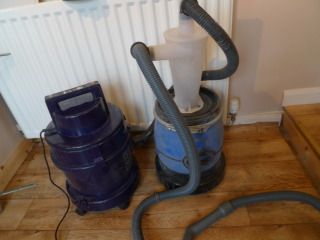nicguthrie
Established Member
I hope someone can explain something to me.
I've been looking for a dust extractor, along with everything else for my workshop I'm putting together and I've noticed while sitting here with a calculator in my hand, that something doesn't quite make sense to me.
I had my eye on the Numatic ARXP470 for it's portability, the 27 litre container, HEPA level filtration, small dimensions, and the excellent reputation of Numatic. The suction is rated at 2700 litres per minute but I was a little worried by the narrow hose, since I plan on using whatever extractor I get for everything from power tools to a bandsaw and probably a bench top planer thicknesser.
I went looking at the non powertool rated bigger machines at this point and this is what left me a little perplexed. The NV750 dust extractor has excellent writeups and a bigger hose, yet the suction, rated as 150m3 per hour actually works out at slightly less than the smaller machine, which if you convert to similar units, is rated at 162m3 per hour. Yet the NV750 is for virtually any machine in a workshop, and the ARXP470 is intended as far as I can see for hand power tools...
I'd have thought a wider hose alone would mean better airflow for the same rated motor. I'm now torn, as if the first machine will handle a bandsaw, lathe and small P/T - it would also fit in my 9x10 internal dimension workshop a lot easier, and kick about from station to station instead of running piping about and such.
Can anyone give me any advice? I have lung problems (had 20 collapsed lungs and then stopped counting) and have already been through cancer, so I'm pretty concerned about keeping air quality high, especially when I want to turn Yew amongst other things. But on the other hand, I have limited space, and would like to stay south of £300 for the extractor if possible.
Any advice or personal experience is most welcome. I can't buy second hand machinery, it's just not an option, has to be new, but I'm new to the whole field myself so please, drop your tuppence worth here if you would, and teach a noobie something!
Nic.
I've been looking for a dust extractor, along with everything else for my workshop I'm putting together and I've noticed while sitting here with a calculator in my hand, that something doesn't quite make sense to me.
I had my eye on the Numatic ARXP470 for it's portability, the 27 litre container, HEPA level filtration, small dimensions, and the excellent reputation of Numatic. The suction is rated at 2700 litres per minute but I was a little worried by the narrow hose, since I plan on using whatever extractor I get for everything from power tools to a bandsaw and probably a bench top planer thicknesser.
I went looking at the non powertool rated bigger machines at this point and this is what left me a little perplexed. The NV750 dust extractor has excellent writeups and a bigger hose, yet the suction, rated as 150m3 per hour actually works out at slightly less than the smaller machine, which if you convert to similar units, is rated at 162m3 per hour. Yet the NV750 is for virtually any machine in a workshop, and the ARXP470 is intended as far as I can see for hand power tools...
I'd have thought a wider hose alone would mean better airflow for the same rated motor. I'm now torn, as if the first machine will handle a bandsaw, lathe and small P/T - it would also fit in my 9x10 internal dimension workshop a lot easier, and kick about from station to station instead of running piping about and such.
Can anyone give me any advice? I have lung problems (had 20 collapsed lungs and then stopped counting) and have already been through cancer, so I'm pretty concerned about keeping air quality high, especially when I want to turn Yew amongst other things. But on the other hand, I have limited space, and would like to stay south of £300 for the extractor if possible.
Any advice or personal experience is most welcome. I can't buy second hand machinery, it's just not an option, has to be new, but I'm new to the whole field myself so please, drop your tuppence worth here if you would, and teach a noobie something!
Nic.






